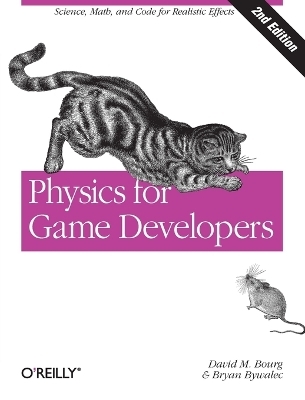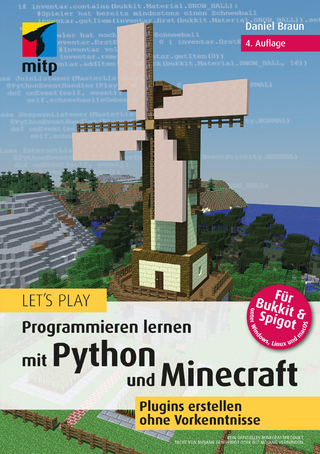
Physics for Game Developers
O'Reilly Media, Inc, USA (Verlag)
978-1-4493-9251-2 (ISBN)
Authors David Bourg and Bryan Bywalec show you how to develop your own solutions to a variety of problems by providing technical background, formulas, and a few code examples. This updated book is indispensable whether you work alone or as part of a team.
- Refresh your knowledge of classical mechanics, including kinematics, force, kinetics, and collision response
- Explore rigid body dynamics, using real-time 2D and 3D simulations to handle rotation and inertia
- Apply concepts to real-world problems: model the behavior of boats, airplanes, cars, and sports balls
- Enhance your games with digital physics, using accelerometers, touch screens, GPS, optical tracking devices, and 3D displays
- Capture 3D sound effects with the OpenAL audio API
David Bourg is a Naval Architect involved in various military and commercial proposal, design, and construction efforts. Since 1998, David has served as an independent consultant working for various regional clients engaged in both commercial and military shipbuilding where he provides design and analysis services including but not limited to concept design, proposal writing, detailed design and analysis, visualization, and software development among other services. He coordinated and led the winning design and proposal effort for the US Coast Guard Point Class (patrol boat) Replacement Program. In 2006, David joined fellow Naval Architect Kenneth Humphreys to form MiNO Marine, LLC, a naval architecture and marine professional services firm. In addition to »Physics for Game Developers«, David has published two other books. He earned a PhD in Engineering and Applied Science in 2008 from the University of New Orleans. He has served as an Adjunct Professor at the University of New Orleans School of Naval Architecture and Marine Engineering, where he has taught various courses since 1993.
Ever since his father read »A Brief History of Time« to him in middle school, Bryan Bywalec wanted to be an astrophysicist. While he will always have a passion for pure physics, he became more and more obsessed in high school with the application of those physical principles he was learning. Having been around sailboats his entire life, his decision to seek a degree in Naval Architecture at the University of New Orleans surprised few. While working on his degree, Mr. Bywalec was employed as a network administrator for the College of Engineering. Having an office in an electronics lab, he explored the world of enterprise computing and became very interested in high performance clusters, remote administration of desktops, and robotics. Upon graduating in 2007, he began his career at MiNO Marine, LLC and, under the guidance of David Bourg and Kenneth Humphreys, now focuses on finite element analysis of complex welded steel structures. His structural analysis work depends largely on the accurate approximations of non-linear physical systems. Bryan has completed several computational fluid dynamics simulations of exhaust gases from ship stacks and current flow around offshore structures. In addition to his work as a naval architect, Bryan strives to create innovative ways to connect everyday objects to various control networks. From unlocking door locks via text message to developing a real time street car tracking program, he constantly searches for opportunities to integrate technology into his life.
Fundamentals
Chapter 1 Basic Concepts
Newton’s Laws of Motion
Units and Measures
Coordinate System
Vectors
Derivatives and Integrals
Mass, Center of Mass, and Moment of Inertia
Newton’s Second Law of Motion
Inertia Tensor
Relativistic Time
Chapter 2 Kinematics
Velocity and Acceleration
Constant Acceleration
Nonconstant Acceleration
2D Particle Kinematics
3D Particle Kinematics
Kinematic Particle Explosion
Rigid-Body Kinematics
Local Coordinate Axes
Angular Velocity and Acceleration
Chapter 3 Force
Forces
Force Fields
Friction
Fluid Dynamic Drag
Pressure
Buoyancy
Springs and Dampers
Force and Torque
Summary
Chapter 4 Kinetics
Particle Kinetics in 2D
Particle Kinetics in 3D
Rigid-Body Kinetics
Chapter 5 Collisions
Impulse-Momentum Principle
Impact
Linear and Angular Impulse
Friction
Chapter 6 Projectiles
Simple Trajectories
Drag
Magnus Effect
Variable Mass
Rigid-Body Dynamics
Chapter 7 Real-Time Simulations
Integrating the Equations of Motion
Euler’s Method
Better Methods
Summary
Chapter 8 Particles
Simple Particle Model
The Basic Simulator
Implementing External Forces
Implementing Collisions
Tuning
Chapter 9 2D Rigid-Body Simulator
Model
The Basic Simulator
Tuning
Chapter 10 Implementing Collision Response
Linear Collision Response
Angular Effects
Chapter 11 Rotation in 3D Rigid-Body Simulators
Rotation Matrices
Quaternions
Quaternions in 3D Simulators
Chapter 12 3D Rigid-Body Simulator
Model
Integration
Flight Controls
Chapter 13 Connecting Objects
Springs and Dampers
Connecting Particles
Connecting Rigid Bodies
Chapter 14 Physics Engines
Building Your Own Physics Engine
Physical Modeling
Chapter 15 Aircraft
Geometry
Lift and Drag
Other Forces
Control
Modeling
Chapter 16 Ships and Boats
Stability and Sinking
Ship Motions
Resistance and Propulsion
Maneuverability
Chapter 17 Cars and Hovercraft
Cars
Hovercraft
Chapter 18 Guns and Explosions
Projectile Motion
Taking Aim
Recoil and Impact
Explosions
Chapter 19 Sports
Modeling a Golf Swing
Billiards
Digital Physics
Chapter 20 Touch Screens
Types of Touch Screens
Step-by-Step Physics
Example Program
Other Considerations
Chapter 21 Accelerometers
Accelerometer Theory
Sensing Orientation
Sensing Tilt
Chapter 22 Gaming from One Place to Another
Location-Based Gaming
What Time Is It?
Location, Location, Location
Chapter 23 Pressure Sensors and Load Cells
Under Pressure
Button Mashing
Barometers
Chapter 24 3D Display
Binocular Vision
Stereoscopic Basics
Types of Display
Programming Considerations
Chapter 25 Optical Tracking
Sensors and SDKs
Numerical Differentiation
Chapter 26 Sound
What Is Sound?
Characteristics of and Behavior of Sound Waves
3D Sound
Appendix Vector Operations
Vector Class
Vector Functions and Operators
Appendix Matrix Operations
Matrix3×3 Class
Matrix Functions and Operators
Appendix Quaternion Operations
Quaternion Class
Quaternion Functions and Operators
Appendix Bibliography
General Physics and Dynamics
Mathematics and Numerical Methods
Computational Geometry
Projectiles
Sports Ball Physics
Aerodynamics
Hydrostatics and Hydrodynamics
Automobile Physics
Real-time Physics Simulations
Digital Physics
Colophon
| Zusatzinfo | illustrations |
|---|---|
| Verlagsort | Sebastopol |
| Sprache | englisch |
| Maße | 178 x 233 mm |
| Gewicht | 885 g |
| Einbandart | kartoniert |
| Themenwelt | Informatik ► Software Entwicklung ► Spieleprogrammierung |
| Naturwissenschaften ► Physik / Astronomie | |
| ISBN-10 | 1-4493-9251-2 / 1449392512 |
| ISBN-13 | 978-1-4493-9251-2 / 9781449392512 |
| Zustand | Neuware |
| Haben Sie eine Frage zum Produkt? |
aus dem Bereich


